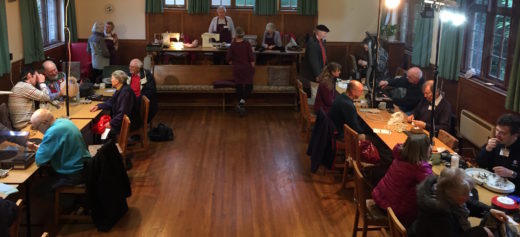The latest at the Repair Café
A while back, I wrote about the Repair Café, which is a monthly event at which a bunch of volunteers endeavor to repair items brought along by members of the public. I have enjoyed being involved with this venture and I am pleased to report on its continued success – we get around 50 “customers” at each session and they report a high level of satisfaction.
However, things have recently taken an interesting turn …
Our local Repair Café was founded 4 years ago by a retired couple, Chris and Jan. Since then, they have managed and organized all aspects of the group, resulting in it being one of the most active [perhaps the most active] Repair Café in the country. A few of months ago, Chris called me and asked whether we might get together “for a chat”. I was intrigued and went to their house one sunny afternoon. They explained that they were planning to leave the area and wanted to hand over the running of the Repair Café to someone else – ideally another couple, who would run it in the way that they had. Was I interested? I responded negatively, as, with a job and numerous other interests and responsibilities, I did not want to take it on and knew that my wife would not have the time and interest either. I said that I thought that it was unlikely that they would find another couple who were as mad [in a nice way] as them. I thought that the way forward would be to establish a management team, thus dividing the work 5-6 ways.
Some weeks later, Chris called again. He said that I was right. No other “mad” couple could be found. How would I like to chair a management team? Well, I like a challenge …
My first thought was that I wanted a team, not a committee. I tend to subscribe to the view that “a committee is the only known life form with six stomachs and no brain”. Committees often spend a lot of time talking and voting on things, with very little being achieved. I felt that a team of semi-autonomous individuals, each with a clearly defined area of responsibility [and authority], would be most efficient. In the ideal world, I would delegate all the work and take all the credit. ? [In reality, I think that this is more the approach of Dilbert’s pointy-haired boss.]
After giving the matter some thought and discussing it further with Chris and Jan, I started to put my team together:
- Treasurer – The amount of money that passes through the organization is quite modest, but it needs to be managed carefully, with everything being accounted for. I asked a friend, who had expressed interest in becoming a repairer to take the job and he accepted.
- Publicity – Ensuring that people know when and where the sessions take place is clearly essential. Also, we need to be able to recruit new volunteers from time to time. I asked another friend, who does exactly this job for my camera club, to take the role. He was excited by the Repair Café concept and readily agreed.
- Catering – A significant part of the operation is supplying tea, coffee and home-made cake to customers and visitors. This is a useful income stream and attracts customers. A lady, who had been doing the bulk of the work in this area, agreed to take the overall responsibility.
- Secretary – There is always some miscellaneous administration to be done. I just needed someone reliable for this job and one of the sewing team [who repair clothes etc.] offered to take the role.
- Quartermaster – The Repair Café has a significant stock of tools and supplies of parts and materials. I felt that this needed some specific management, with someone focussed on keeping it in order. One of the repairers had been critical of this area, so I presented him with a “put up or shut up” option, so he was swiftly on board.
So, my team was assembled and the first session with us “in charge” was just before Christmas. I was quite nervous and had a few somewhat sleepless nights, worrying about some of the details. Although, knowing that Chris and Jan would still be around should have been a comfort [and it was]. The day arrived. I went to the venue very early and started getting things set up. I had decided to only do repairing if we were exceptionally busy. All the volunteers showed up and started doing their jobs. We opened at 10:00. By 10:15, coffee was being served, customers were being looked after and repairs were taking place. I will admit to feeling quite emotional. Having a great team around me, all pulling in the same direction was a great feeling, which offset my prior anxiety.
We now look to the future. In the short term, we need to maintain the service that Chris and Jan worked so hard to establish. In due course, we will start to look at ways to do even better. An area of concern is our demographic; we need to attract more younger [under 40s] people to come along as customers and, hopefully in the longer term, repairers. We will also want to do our best to support the setting up of other Repair Café groups in nearby towns.
If you want to know more about Repair Cafés or, perhaps, you would like to set one up where you live, do contact me via email or social media.
